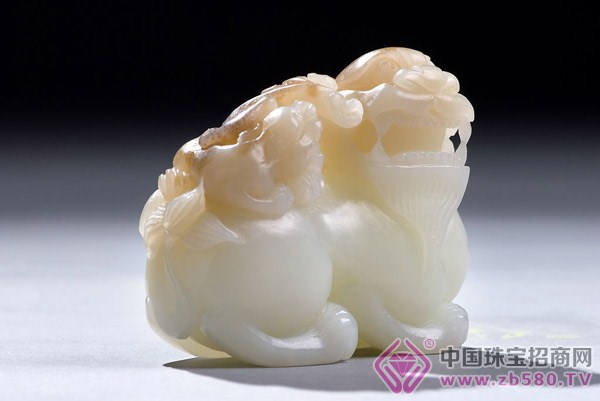Indulge in the realm of "pan" jade
The "disc" mentioned here is not a flat and shallow tool for holding objects, but an action of constantly rubbing the objects by hand. Collecting antiques, people who love to play, often spend time playing with their beloved artifacts, such as stone, plate jade, or bronze, porcelain, wood, teeth and so on. Why use the "disc" to refer to the action of this constant smashing artifact? There is a detailed explanation in "Said Wen Jie Zi": the disk is a water-bearing device, with the water and the water, the ancients will sprinkle their hands, and the day is all day, and the day is new. Therefore, the "disc" is used in this movement, which refers to the constant exchange of people and objects, reaching a new state of the day. This day is a new state, which has two meanings: First, the artifacts play through the disk, change every day, and the day is new; first, as the players understand the artifacts gradually, the emotions and mentality are new every day. . In theory, the human hands play a sanding-like grinding effect in the process of playing the utensils, and there is no excessive sanding, which will not cause physical damage to the objects. At this point, the so-called modern rapid means such as sandpaper, angle grinders, and various chemical acids are not as vivid and natural as the changes in the objects played by the discs. After playing for a long time, the surface of the object gradually produces a translucent texture of the patina, which inadvertently reshapes the image of the object, making it more comfortable, warm and pleasant. The patina can be caused by soil immersion, but the best is the traces of the years left after playing. It is calm and calm, showing a gentle sense of time, the glare of new objects and the thief It is not the same. Not only the hard, volumetric stoneware, porcelain, wood, bronze, and horns are easy to form a patina, and even the thin and sleek paper-like products of the calligraphy and paintings are all in the eyes of the insiders. . Almost all traditional Chinese collections can be played and then form a faint glow with special memories. For Westerners, palate is nothing more than a sweat, oil, and a mixture of delicate and natural weathering. However, in the eyes of the Chinese, this rare surface hull cannot be formed for many years. It varies from artifact to object. It takes years, decades or even hundreds of years to produce the patina, so from the degree of patina, not only can it be approximated. Seeing the age of the artifacts, I can also feel the temperature that the player likes. The differences between Eastern and Western cultures are also very different in the game. Taking stone as an example, Chinese stones, whether jade, jade, Qingtian stone, Shoushan stone, or Lingbi stone, Taihu stone, Yingshi, Kunshi, etc., are all based on the thick patina after playing. Western diamonds, red sapphires, or emeralds, opals, etc., after being touched, the original dazzling light retreats, it needs to be re-cleaned to ensure the characteristics of transparent and shiny. This is even more dazzling after playing with Chinese utensils, the opposite. Not only Western artifacts are not suitable for playing, modern materials such as stainless steel or plastic are not suitable for playing. The objects made of these materials, such as mobile phones, even if everyone does not leave their hands, repeatedly rubbing, but this billions of movements, after all, do not have the cultural connotation of playing. On the other hand, the objects that the Chinese are keen on playing are all natural materials. The process of natural materials aging in nature is actually very beautiful. The artificial materials that are now synthesized, in any case, do not reach the simple and profound nature of natural objects. In the process of playing, because of the close contact with the objects, the Chinese have discovered many special beautys - such as the azure of porcelain, which is a touch of pale blue after the rain; for example, the azure in the end, it is the night The clear and deep of the clear sky. These not only emphasize the beauty of the natural materials themselves, but also challenge the possibilities of the production process. The actual completion of an artifact is not in the hands of the craftsman, but in the hands of the player for a longer period of time. Nature and great craftsmen provide a vehicle that can be constantly empowered by players. Culture, in the process of constantly giving emotions, is passed on from generation to generation. Beware of some singularity, transforming natural materials into trivial and even vulgar, not only can not play, transport, display hard, but also isolated from the hands of the favorite. Thus, the life of the work is over in the hands of the craftsman and in the working environment. Everyone across the glass, in addition to admiring the craftsman's "smart axe", but can not experience the temperature and texture of the objects in their hands, the interesting characters intersection, you will not cut off half of life! A mask is a sanitary product, usually worn at the mouth and nose to filter the air entering the mouth and nose to prevent harmful gases, odors and droplets from entering or leaving the wearer's mouth and nose. It is made of gauze or paper.Masks have a certain filtering effect on the air into the lungs, in the respiratory tract infection epidemic, dust and other pollution in the environment, wearing masks has a very good effect. Disposable face mask, Earloop face mask, Kn95 face mask, Kids face mask, Ffp2 face mask, Civil face mask Shenzhen MingFengXing Art & Craft Products CO., LTD. , https://www.mf-gift.com